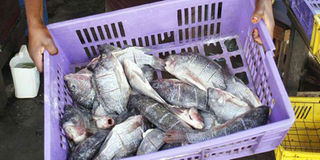Increase in price of meat, fish pushes up inflation

Moving upwards. Fish prices rose in the period to October forcing inflation to move northwards. FILE PHOTO
What you need to know:
- The increase, he said, was due to annual other goods inflation that increased to 3.4 per cent for the period compared to 3.3 per cent in September.
- Annual Energy Fuels and Utilities inflation increased to 5.1 per cent compared to 2.5 per cent recorded for the year ended September.
The increase in prices of meat, fish and some food crops has seen inflation move northwards to 2.5 per cent for the year ended October.
The increase means that Ugandans spent more money in October to buy the same basket of items or access a service compared to what they spent in September.
Releasing the Consumer Price Index in Kampala yesterday, Mr Vicente Nsubuga Musoke, the Uganda Bureau of Statistics principal statistician price statistics, said the annual headline inflation for the year ending October, was recorded at 2.5 per cent compared to the 1.9 per cent recorded in during September.
The increase, he said, was largely driven by annual food crops and related items inflation, which increased to -0.9 per cent in the period compared to -3.0 per cent in September.
Other food crops and related items inflation included fruits inflation, which increased to -8.1 per cent compared to -13.8 per cent vegetable inflation increased to 4.9 per cent from 4.7 per cent in the period under review.
During the period, Mr Nsubuga said, the average price of meat per kilogramme increased to Shs12,000 up from Shs10,000 while a kilogramme of fish increased to Shs15,000 up from Shs12,000.
“In particular, annual inflation for meat increased to 4.6 per cent for the year ending October compared to the 3.5 per cent in September. Fish inflation increased to 3.2 per cent from 1.1 per cent,” he said, noting that services inflation remained stable at 1.5 per cent.
Earlier, the Central Bank had projected that risks to the inflation outlook were largely on the downside, forecasting it to converge to the target of 5 per cent in the next two or three years.
Mr Nsubuga said core inflation, which measures the costs of goods and services apart from those in the food and energy sectors, increased to 2.6 per cent for the year ending October compared to 2.5 per cent in September.
The increase, he said, was due to annual other goods inflation that increased to 3.4 per cent for the period compared to 3.3 per cent in September.
Annual Energy Fuels and Utilities inflation increased to 5.1 per cent compared to 2.5 per cent recorded for the year ended September.




